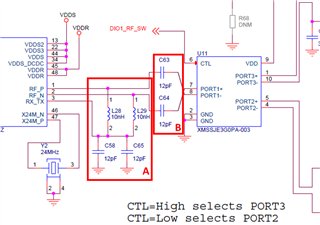Other Parts Discussed in Thread: CC1350, CC1310, LAUNCHXL-CC1310
Hi,
In case we don't use the switch in CC1350 (In case we use single frequency);
1) Do the components (2) between the chip and the switch need to be used, ie the components C63, C64, L29, L28, C58 and C65? If these components are not needed, should the connection (3) of the capacitors C72 and C73 of the balun be connected directly to the RF_P and RF_N pins (1)?
2) If the switch is not used, do the components in 2 need to be recalculated?, What is their function and how should I calculate it?
Thank you in advance for your answers.
Kind regards.


